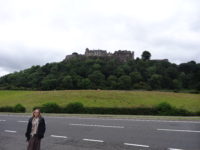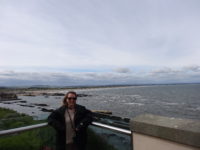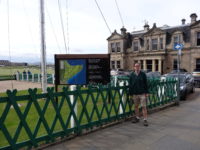 We had a good little chat with our B and B host before leaving Stirling; he told us some places to see, some of which I hope to incorporate when it is “my” week next week. Our host was a very friendly and helpful man, and I would highly recommend his B and B for any one staying in the Stirling area when in Scotland (Number 10 Bed and Breakfast).
We had a good little chat with our B and B host before leaving Stirling; he told us some places to see, some of which I hope to incorporate when it is “my” week next week. Our host was a very friendly and helpful man, and I would highly recommend his B and B for any one staying in the Stirling area when in Scotland (Number 10 Bed and Breakfast).
We hopped in the car and used mercifully large roads to head over to Dundee. Meredith helpfully counted the roundabouts we had to navigate in an hour (thirteen, I think); after a couple of missed turns and some construction, we arrived in Dundee at Discovery Point. It sounds like a hands-on science museum, but it is actually a museum dedicated to the sailing and steam ship Discovery, which took Commander Scott and forty-five men to Antarctica in 1901 to explore the continent and study it for science. The expedition lasted two years, and the small museum did a fantastic job of presenting the building and stocking of the ship, the men who sailed her, the difficulties they faced, some of the discoveries they made, the difficulty in getting out of the ice after two years, and what happened to the ship after they returned home. The museum also usually includes touring the Discovery herself, but the ship is currently being worked on for conservation purposes, so that part of the museum was closed. We still spent two hours at the museum, and could probably have spent another hour if we’d had the time (and if our parking had not expired).
 The museum was well laid out, with rooms dedicated to a theme – the building of the ship, the men who manned her, the science that was discovered, and so on. Each room had short videos to help explain the room, as well as typical information placards, as well as the audio guides we rented. They also had a good ten-minute overview film partway through the exhibit to break up the rooms. I was very impressed. Some of the fun facts we learned:
The museum was well laid out, with rooms dedicated to a theme – the building of the ship, the men who manned her, the science that was discovered, and so on. Each room had short videos to help explain the room, as well as typical information placards, as well as the audio guides we rented. They also had a good ten-minute overview film partway through the exhibit to break up the rooms. I was very impressed. Some of the fun facts we learned:
– The ship was made of wood because wood flexes under ice pressure, whereas steel and iron are brittle. The hull was twenty-six inches thick and made of seven different types of wood for strength, as well as the bow being reinforced with steel for cutting through the ice.
– Dundee was selected to build the ship because most places had forgotten how to build wooden ships. Since Dundee was a center for whaling ships, which were made of wood for flexing against ice, Dundee still knew how to make them.
– Discovery was a triple-masted sailing ship with a steam engine for emergencies or for ramming through ice. Coal was too bulky to bring along in sufficient quantity for regular propulsion, so they sailed most of the time.
 – In addition to the men, the captain brought along a cat.
– In addition to the men, the captain brought along a cat.
– The conditions were harsh, and the expedition lasted two years. The ship was freed from ice in February 1903 by help from relief ships sent, the use of gunpowder to blow the ice, and a shifting wind that aided in ice breakup.
– Discoveries included the life cycle of the king penguin, many new species, proof that Antarctica was a continent (as opposed to islands or just ice), the realization that the magnetic field changed slightly before the Auroras appeared, the detailed mapping of a large section of coastline, the penetration into the interior, and more.
The expedition was a huge success. Eleven volumes of scientific findings were published, as well as many specimens being brought back for museums. Commander Scott became famous and returned to Antarctica a few years later, reaching the South Pole a few weeks after a Norwegian explorer got there first. Scott and his four companions all passed away on the return trip, falling just eleven miles short of a resupply station that would have saved some of them. One of the Discovery‘s junior officers, Shackleton, returned as well, and when his ship was destroyed, he set off to row eight hundred miles to South America to get help, with just three others in a large rowboat. He made it, and all the men survived.
 We left the museum and drove the short distance to St. Andrews, the birthplace of golf, including the world-famous Old Course. It also houses the University of St. Andrews, where we’re staying in a small but nice dorm room. After getting situated, we walked into town to tour around, but first to get ice cream. As we were standing at a crosswalk looking confused, a woman offered to help us. We got to talking, and in another small-world moment, she turned out to be the aunt of a CVCA alumna who is married to one of Meredith’s former students, so the woman had been to Stow and Cuyahoga Falls and knew where they were. She also knew where the ice cream place was, and it was good to get ice cream, even if the day was only fifty-five degrees out (with a brisk wind).
We left the museum and drove the short distance to St. Andrews, the birthplace of golf, including the world-famous Old Course. It also houses the University of St. Andrews, where we’re staying in a small but nice dorm room. After getting situated, we walked into town to tour around, but first to get ice cream. As we were standing at a crosswalk looking confused, a woman offered to help us. We got to talking, and in another small-world moment, she turned out to be the aunt of a CVCA alumna who is married to one of Meredith’s former students, so the woman had been to Stow and Cuyahoga Falls and knew where they were. She also knew where the ice cream place was, and it was good to get ice cream, even if the day was only fifty-five degrees out (with a brisk wind).
We headed down through the town to the Old Course to check it out, swinging by the Museum of the University of St. Andrews, mostly to use the restrooms, but the four-room exhibits were interesting to breeze through, and they had a wonderful terrace overlooking the beaches. We got down to the Old Course, and it is immaculate, with a fairway that looks better than some greens I have seen. We snapped some pictures, and wanted to get a picture of the small stone bridge on the eighteenth hole, when we saw normal folks walking out on the course and getting a picture. One man laughed that the golfers were good enough to miss the people there. So we walked out between golfers and grabbed a photo. Also odd for a world-famous course, there is a road/path through the middle of the fairway across two holes. Drivers and pedestrians are warned by signs that there are golfers playing. Fair enough.
 Next on the list was heading down to the two-mile-long West Beach. The beach is beautiful and is where the opening sequence to the move Chariots of Fire was filmed, so Mer wanted a picture of me running. We found it amusing that there were three lifeguards on duty; not only were there howling winds and cool temperatures, leading to no swimmers, but the lifeguard shack was fully enclosed, presumably to protect against the elements.
Next on the list was heading down to the two-mile-long West Beach. The beach is beautiful and is where the opening sequence to the move Chariots of Fire was filmed, so Mer wanted a picture of me running. We found it amusing that there were three lifeguards on duty; not only were there howling winds and cool temperatures, leading to no swimmers, but the lifeguard shack was fully enclosed, presumably to protect against the elements.
We walked back up to town, following a walking guide from Mer’s Ricks Steves guidebook. We stuck our heads into the main courtyard of the downtown location of the University St. Andrews, and then over to and along the cliffs of the town, and down to the small East Beach, which is at the foot of a ruined castle. The castle was destroyed at some point during the Scottish Reformation as Protestants and Catholics fought each other. We got to the castle after 5:00, so the museum and castle grounds were closed. We kept walking and were suddenly overtaken by a large group of mostly middle-aged runners and walkers. We are not sure what they were running for, but we got out of their way, since the path was narrow. We made our way down to the ruined cathedral, but it also was closed for the day. The cathedral was not destroyed suddenly, but fell into disuse and fell apart over a couple of hundred years. We finished our walk though the town through some back lanes and the oldest section, and then we found a place for supper. My hands were pretty well frozen, so I was very pleased the bar/restaurant served hot chocolate.

We put in a good walking show today, logging over ten miles. I suspect I will sleep well tonight.
For avid golfers and fans, a bit of inclement weather is a small price (in addition to the $200.00) to pay for the honour of treading the fairways, greens, and maybe an occasional sand trap or water hazard that the likes of Sam Snead, Bobby Jones, Arnold Palmer, Seve Ballesteros, Jack Nicklaus, Phil Mickelson, and many others have walked.
It was a tad more than a bit… 🙂
BUT, even Mer and I felt the importance of the 18th hole; it was very cool we got to walk out on the course. I never though they would let people do that, but they do. The golfers just play around people on the stone bridge.